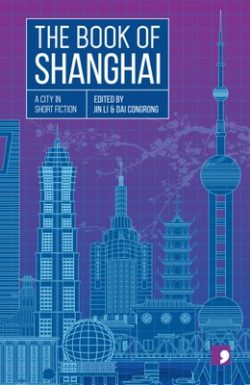The Book of Shanghai, by various authors
Edited by Dai Congrong & Dr Jin Li
by Wang Anyi, Xiao Bai, Shen Dacheng, Chen Danyan, Cai Jun, Chen  Qiufan, Xia Shang, Teng Xiaolan, Fu Yuehui & Wang Zhanhei
Qiufan, Xia Shang, Teng Xiaolan, Fu Yuehui & Wang Zhanhei
Translated by: Lee Anderson, Yu Yan Chen, Jack Hargreaves, Paul Harris, Frances Nichol, Christopher Macdonald, Carson Ramsdell, Josh Stenberg, Katherine Tse, and Helen Wang.
Comma Press, 2020
Publisher's Blurb
As the end of the world arrives in downtown Shanghai, one man’s only wish is to return a library book...
When a publisher agrees to let a star author use his company’s attic to write in, little does he suspect this will become the author’s permanent residence...
As Shanghai succumbs to a seemingly apocalyptic deluge, a man takes refuge in his bathtub, only to find himself, moments later, floating through the city's streets...
The characters in this literary exploration of one of the world’s biggest cities are all on a mission. Whether it is responding to events around them, or following some impulse of their own, they are defined by their determination – a refusal to lose themselves in a city that might otherwise leave them anonymous, disconnected, alone.
From the neglected mother whose side-hustle in collecting sellable waste becomes an obsession, to the schoolboy determined to end a long-standing feud between his family and another, these characters show a defiance that reminds us why Shanghai – despite its hurtling economic growth –remains an epicentre for individual creativity.
Reading Chinese Network Reviews
Reviewed by Stella Jiayue Zhu, 21/6/21
 Ending his preface to The Book of Shanghai, an ably curated collection of ten short stories by local authors set in the contemporary city of its eponym, editor Jin Li writes that this anthology is meant to offer ‘a literary map of the city’.
Ending his preface to The Book of Shanghai, an ably curated collection of ten short stories by local authors set in the contemporary city of its eponym, editor Jin Li writes that this anthology is meant to offer ‘a literary map of the city’.
There is a well-known Shakespearean dictum equating cities with their residents: ‘what is the city but the people?’ If the idea is right, then to trace out a map of Shanghai, we must look into the souls of its residents. That is precisely what this book does. Filled to the brim with real-life local types, it provides an experience of Shanghai as authentic as there can be from a distance. On that note, it accomplishes Jin’s goal with real success.
The Book of Shanghai kicks off with slices of domestic life, presented by some of the most well-known Shanghainese authors currently working.
"Ah Fang’s Lamp" by Wang Anyi observes the daily routine of a family of fruit vendors in painstaking detail and explores the possibility for a quiet, mundane, yet substantive kind of joy. Chen Danyan’s "Snow" allows us a glimpse into the mind of the Shanghainese petits bourgeois through the prism of a ‘female intellectual’—a kind of character typically associated with the progressive Shanghai and whom Chen is especially known for portraying—who overcomes a moment of mid-life crisis at the sight of fresh, virgin snow. "Woman Dancing under Stars" by Teng Xiaolan depicts the unlikely friendship between a young newlywed woman and an elderly widow. Under a veneer of romanticism, her story is a sobering observation of the everyday trauma that domesticity can bestow on women in marriages, whose cure ultimately lies in self-care and the formation of friendships from without.
This theme of alienation, of desiring intimacy and being denied of it, is echoed by other stories in the collection. "The Lost" by Fu Yuehui, "Transparency" by Xiao Bai, and "The Story of Ah-Ming" by Wang Zhanhei all deal with ideas in the neighborhood. "The Lost", in particular, zooms in on a typical ‘Shanghai rover’, someone from the provinces who comes to ‘make it’ in the metropolis. It is a sympathetic exposé of urban technological living at its worst: being deprived of meaningful human contact and offered a mere illusion as compensation.
Thankfully, it’s not all grim. The metropolis, as much as it severs companionship and breeds loneliness, also helps us recognize the strangeness in our conditions of existence by destabilizing it. This may be why several stories in the collection employ elements of surrealism.
"The Novelist in the Attic" by Shen Dacheng, who represents a newer generation of Shanghainese authors, provides such an example. It takes a turn to look, introspectively, at the storyteller. The premise is unassuming: a novelist takes residence in an attic office above the publisher’s to concentrate on writing. Quickly, however, the plot spirals into surrealism reminiscent of the style of Julio Cortázar. Like Cortázar’s House Taken Over (Casa Tomada), Shen’s story also explores the relationship between identity and inhabitancy. It is an incredible tale that ends with a bang.
"Suzhou River" by Cai Jun, who first made a name for himself in the suspense and horror genre two decades ago, and "State of Trance" by science fiction writer and translator Chen Qiufan similarly make use of the unreal. "Suzhou River" wades through a dreamlike landscape, figuratively and literally, as Cai imagines a great flood that takes over Shanghai. "State of Trance" is set on the cusp of a total dissolution of human consciousness. As the apocalypse unfolds, our nameless protagonist embarks on a pilgrimage: to return a book to Shanghai Library on foot. Both tales are driven, plot-wise, by some sort of meandering through the city. Consequently, they contain the most concrete and detailed geographic references in the whole anthology.
Make no mistake, the collection is rich with local imageries—from the 95°C Bakery penned by Teng Xiaolan to the Wutong trees lining Shen Dacheng’s streets, and even the stench of garbage bins on collection day detailed by Wang Zhanhei—there is an unambiguous sense of geographic cohesion, recognizable to anyone who’s spent time in Shanghai.
Still, "State of Trance" and "Suzhou River" stand out. Here, the city with its complex topography truly emerges as an active character, capable of shaping and destroying the human protagonists, with the potential of even outlasting them. This antagonistic character of the contemporary metropolis is a latent theme in other stories anthologized in The Book of Shanghai. But here, it is physically manifest, in the form of urban catastrophes. Curiously, neither story treats the catastrophe as inherently bad. In the case of Chen, one might even think that his tone is one of curiosity and expectancy. (‘The city will survive,’ says the protagonist of "State of Trance" to himself in his last moments of consciousness.) As much as it subverts our ordinary identification between a city and its citizens, in a certain way, this may actually be the purest celebration of Shanghai, in and of itself.
I should note that the anthology ends with "State of Trance". This could be a coincidence. Even if so, it is still fortuitous: in style, tone, and outlook, "State of Trance" cannot be further away from "Ah Fang’s Lamp", which is the very first story to greet us. If a literary map is capable of taking us so smoothly so far, it must indeed be a very good map.
Reviewed by Stella Jiayue Zhu
Reviewed by Rebecca Ehrenwirth, 12/2/21
 This wonderful collection of contemporary Chinese short-stories brings together a wide variety of different authors and topics.
This wonderful collection of contemporary Chinese short-stories brings together a wide variety of different authors and topics.
The most vivid descriptions of Shanghai can be found in Yunnan-born Fu Yuehui’s “The Lost” and Cai Jun’s “Suzhou River”. The narrator in “The Lost” impressively conveys the vastness of Shanghai by telling a story about a lost mobile phone: “Life had suddenly become a vast, empty wilderness” – a sentence in which the word life can easily be replaced by Shanghai, and the readers can imagine themselves wandering around in the metropolis, hoping to not getting lost. The story makes the reader realize how we always talk about freedom when in fact we are dependent on modern technology, i.e. our phones which contain “countless human connections”. But it also makes one understand how we feel connected to others while indeed many of these connections are not very deep. In fact, they are so superficial that we often can’t remember names, let alone phone numbers of acquaintances. Cai Jun’s story also focuses on the size of the city by calling it a “giant labyrinth” and by naming its citizens her “slaves”. The narrator tells the readers about the colonial influences one finds in Shanghai but mainly concentrates on the Suzhou river by which the protagonist is being chased.
The short-story collection, however, starts with a very poetic story by Wang Anyi, one of the most prominent Shanghai writers. In “Ah Fang’s Lamp” we not only find intertextual references to The Dream of the Red Chamber but we are also drawn into a story-within-a-story. The skilful translation by Helen Wang sometimes uses alliterations to emphasize the ups and downs, the to and fro of life in the city streets of Shanghai, which are “bright and breezy”.
Meanwhile, the lesser known female writer Shen Dacheng uses metafiction to draw the attention to the act of writing. Herself being new to Shanghai’s literary circle, she has already attracted attention due to her unique writing style.
With regards to translation, “The Story of Ah-Ming” by Wang Zhanhei was certainly one of the more complicated one to translate as it plays with Chinese characters, such as when the narrator explains to the reader that the character for “grasping” as in “the Rubbish Man grasps rubbish from the bins” is indeed visually very appropriate. The translator Christopher McDonald accentuates this focus on language by using colloquial expressions, such as “schlep upstairs” to catch the readers’ eyes.
The collection closes with a story by the Award-winning Chen Qiufan, in which he uses the 2nd person, a rather unusual point of view. By using “you” the reader is directly included and lead through Shanghai, following the footsteps of the protagonist.
With five female writers (Wang Anyi, Chen Danyan, Teng Xiaolan, Shen Dacheng and Wang Zhanhei) the collection represents a rather gender-balanced selection of contemporary Shanghai writers. Regarding themes and writing style, there just happens to be something for everyone, which makes the whole collection a very enjoyable and worthwhile reading.
Reviewed by Rebecca Ehrenwirth
Reviewed by Kate Costello, 8/6/20
 The Book of Shanghai is a short story collection at its best: the stories collected are varied and fresh, offering an unexpected, intimate and poignant portrait of the city.
The Book of Shanghai is a short story collection at its best: the stories collected are varied and fresh, offering an unexpected, intimate and poignant portrait of the city.
It’s only natural that a literary tribute to contemporary Shanghai would start with Wang Anyi. 'Ah Fang’s Lamp' sets the tone for the rest of the collection from the very first sentence: “People often have grey days, just as there are sometimes grey skies.” Her languorous pacing and emotive description leave the reader with a bittersweet sensation, a lingering sadness that doesn’t quite arrive at nostalgia. The story is a compassionate exploration of chance encounters and the narratives we construct around them. Wang Anyi memorializes the prosaic, the mundane, and the insignificant. In this way her story can be seen as a miniature of the collection as a whole, commemorating Shanghai as a living city, its side streets on wet grey days and bright sunny days, abandoned in the dripping rain or boisterous with the laughter of children.
The stories that ensue paint a portrait of Shanghai’s unseen details. The collection is remarkably cohesive, united by these concrete details that all too often escape our notice—the waving leaves of the camphor trees that stretch skyward, the grey little alleys, the benevolent face of a taxi driver, the old lady collecting bottles, the boy who “hopped out of the doorway like a flea” (26), the smell of scallion pancake. The architectural features that the city is renowned for also appear, but they are dwarfed by the human relationships that are forged or thwarted beneath their proud silhouette. The collection is an homage to relationships, real or imagined, actualized or impossible. While the city is often represented in the popular imagination as a site of alienation and thwarted promise, these short stories show a different side of the city: a refuge where people can take comfort in the familiar. Where closeness can provide a moment of solace, even if it is dreamed. There is no shortage of estrangement in these stories, but the face it takes is less radical and less dehumanizing than usual. In these stories, estrangement can also be a kind of comfort.
The collection is remarkable for bringing together such a wide variety of authors and literary styles. Each story that unfolds is a surprise, and the varied pacing makes the book enjoyable to read straight through without the feeling of inertia that accompanies some short story collections. The range of translators also breathes life into the portrayal of the city, as each story has its own diction and idiosyncrasies. While too many different voices can be a distraction in a translated collection, it serves well here. The only instance that jolted me out of the Shanghai ambience was Ah-Ming’s declaration that living downstairs, “Saves you from having to schlep upstairs” (85), followed by the interjection “Oi, old woman!” (86), which made me think for just a moment that she might in fact be a Jewish grandma.
The characters that emerge in this collection are memorable and distinct, even after one has put the book down. This is the mark of a successful short story collection, if a few days later, the characters are still pacing around in your head with a life of their own. The twists and turns of this collection and its evocative details linger long after reading. Inside during quarantine, my mind keeps returning to Ah Fang’s son, still sleeping despite the pelting rain; to the writer, frenzied in his attempts to finish his trilogy; to Ms. Zhuge, with her steak and wine and dancing stars; to Ah-Ming and her apartment full of rubbish.
To compile a collection that lives up to the name The Book of Shanghai is no easy task, and the editors Jin Dai and Li Congrong should be commended for bringing together such a vivid and wide-reaching collection of stories. With such an immense body of texts to choose from, the collection could easily expand to an unwieldy size or lose any sense of cohesion. Jin Dai and Li Congrong’s steadfast focus and editorial vision makes this collection a great success. The authors and translators featured are a great representation of what makes Chinese literature today so exciting.
Reviewed by Kate Costello
Reviewed by Ruth Matanda, 4/6/20
 The city of Shanghai has long been imagined as a place unlike any other in China, an international and affluent city with infinite possibilities where people from all over the world and of different social classes live side by side, centred between the traditional and modern China. The Book of Shanghai, which is a collection of short stories by established and emerging writers, presents to us the lives of different individuals from all walks of life and how they navigate living in a city where impossible events become possible and as a result reality becomes stranger than fiction. The idea of Shanghai being a strange place where bizarre events happen is most prominent in stories such as ‘Suzhou River’, ‘The Novelist in the Attic’ and ‘State of Trance’ where the authors utilise elements of magical realism to explore the theme of identity, particularly its creation and fragility; the characters in each of these stories are presented as experiencing an internal mental struggle. ‘Suzhou River’ focuses on the power of the human imagination and Cai Jun imagines what could happen if the self is placed under immense stress or harbours feelings of fear, in the case of the protagonist the fear of reuniting with the woman he has loved for many years seems to result in a prolonged state of anxiety which causes the whole city to flood and residents to drown. Chen Dacheng’s ‘The Novelist in the Attic’ also explores the concept of creation of the self (or multiple selves) albeit in a more morbid manner. This story was the one which left the biggest impression on me, I enjoyed the shift in tone and the sharp contrast between the beginning of the story (which was quite innocent, following the dreams of an emerging author) and the end which takes a rather dark turn. The subtle commentary which the story makes on a society which demands their creatives to push themselves to the brink of insanity to achieve perfection was very well executed by Chen.
The city of Shanghai has long been imagined as a place unlike any other in China, an international and affluent city with infinite possibilities where people from all over the world and of different social classes live side by side, centred between the traditional and modern China. The Book of Shanghai, which is a collection of short stories by established and emerging writers, presents to us the lives of different individuals from all walks of life and how they navigate living in a city where impossible events become possible and as a result reality becomes stranger than fiction. The idea of Shanghai being a strange place where bizarre events happen is most prominent in stories such as ‘Suzhou River’, ‘The Novelist in the Attic’ and ‘State of Trance’ where the authors utilise elements of magical realism to explore the theme of identity, particularly its creation and fragility; the characters in each of these stories are presented as experiencing an internal mental struggle. ‘Suzhou River’ focuses on the power of the human imagination and Cai Jun imagines what could happen if the self is placed under immense stress or harbours feelings of fear, in the case of the protagonist the fear of reuniting with the woman he has loved for many years seems to result in a prolonged state of anxiety which causes the whole city to flood and residents to drown. Chen Dacheng’s ‘The Novelist in the Attic’ also explores the concept of creation of the self (or multiple selves) albeit in a more morbid manner. This story was the one which left the biggest impression on me, I enjoyed the shift in tone and the sharp contrast between the beginning of the story (which was quite innocent, following the dreams of an emerging author) and the end which takes a rather dark turn. The subtle commentary which the story makes on a society which demands their creatives to push themselves to the brink of insanity to achieve perfection was very well executed by Chen.
For me each of the stories in the collection conveys a feeling of desperation, loneliness and emptiness, emotions which contrast to living in a large city which seems to connect so many people, yet only on the surface. There is a general apathetic attitude conveyed by some of the protagonists and almost all of the secondary characters. A good example of this is in Wang Zhanhei’s ‘The Story of Ah Ming’ where I was saddened by the attitude which Ah Ming’s neighbours and old friends had towards the slow deterioration of her mental health, instead of helping her, they pass judgement and treat her as an outcast, someone no longer useful to society. Tales such as ‘The Story of Ah Ming’ gave me the feeling that the authors were not trying to demonise Shanghai but rather were trying to highlight that perhaps the problem lies with the inhabitants who struggle with defining who they are as individuals due to the superficial nature of their relationships. This insecurity in their identity causes the occurrence of supernatural events or loss.
Despite being short, each story has many layers to unpack, furthermore the ambiguity which almost all of the authors deploy (the characters’ intentions and causes of the events are often left unexplained) means that the stories are open to many different interpretations. Another thing I enjoyed was the pacing as each of the stories are well contained and the decision to focus on only one or two characters strengthened the feeling of the characters being alone despite being in an immense city like Shanghai; interactions with others are often short and as readers we feel the disconnect that the characters feel to their society and each other.
Due to the diversity of genres (from science fiction to classical romanticism and even surrealism) this is a great book which has something for everyone. It exposes the reader to the different sides of Shanghai, from the mundane lives of the working class in ‘Ah Fang’s Lamp’ to navigating family drama and infidelity in ‘Bengal Tiger’ and ‘Transparency’.
Overall I think this is a brilliant anthology that is about people trying to connect to others to feel a sense of belonging and acceptance whilst trying keep themselves sane and afloat in a city that feels like it is constantly on the brink of collapsing.
Reviewed by Ruth Matanda
